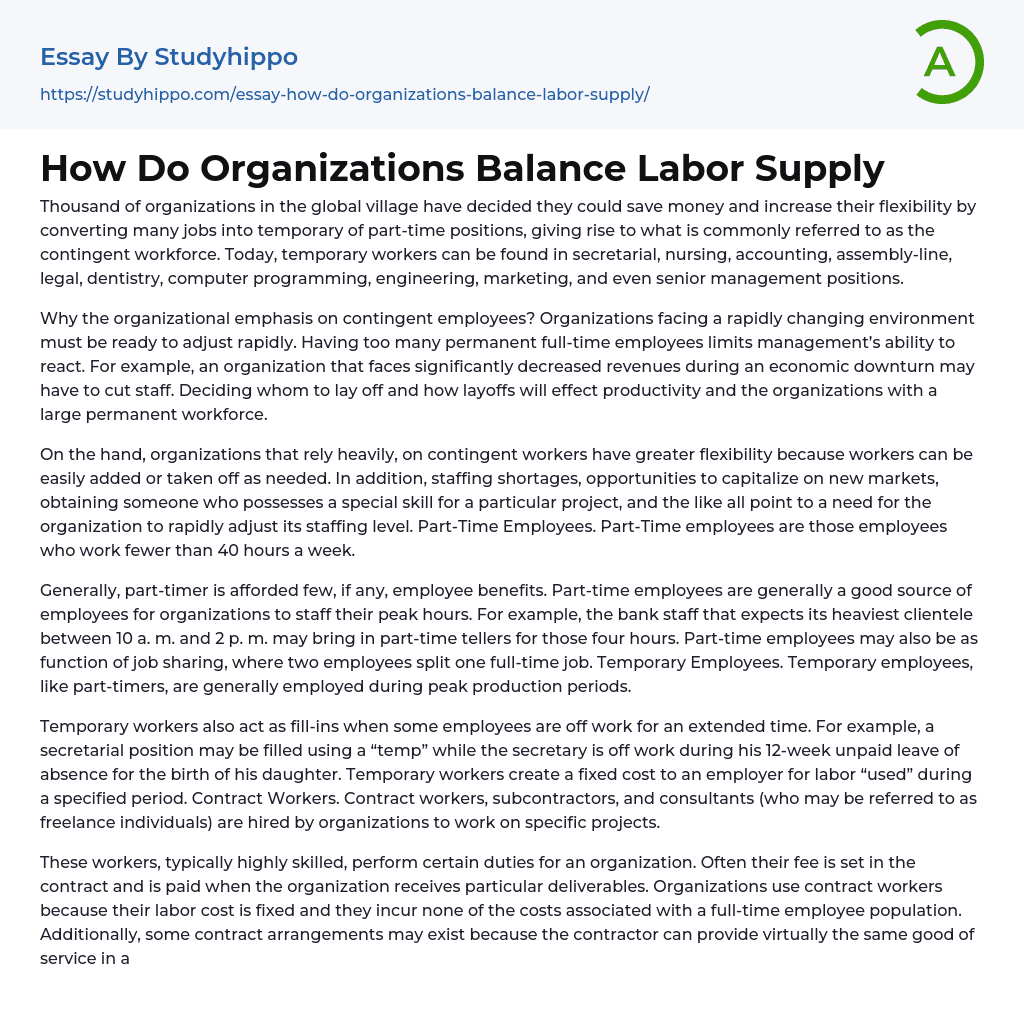Thousand of organizations in the global village have decided they could save money and increase their flexibility by converting many jobs into temporary of part-time positions, giving rise to what is commonly referred to as the contingent workforce. Today, temporary workers can be found in secretarial, nursing, accounting, assembly-line, legal, dentistry, computer programming, engineering, marketing, and even senior management positions.
Why the organizational emphasis on contingent employees? Organizations facing a rapidly changing environment must be ready to adjust rapidly. Having too many permanent full-time employees limits management’s ability to react. For example, an organization that faces significantly decreased revenues during an economic downturn may have to cut staff. Deciding whom to lay off and how layoffs will effect productivity and the organizations with a large permanent work
...force.
On the hand, organizations that rely heavily, on contingent workers have greater flexibility because workers can be easily added or taken off as needed. In addition, staffing shortages, opportunities to capitalize on new markets, obtaining someone who possesses a special skill for a particular project, and the like all point to a need for the organization to rapidly adjust its staffing level. Part-Time Employees. Part-Time employees are those employees who work fewer than 40 hours a week.
Generally, part-timer is afforded few, if any, employee benefits. Part-time employees are generally a good source of employees for organizations to staff their peak hours. For example, the bank staff that expects its heaviest clientele between 10 a. m. and 2 p. m. may bring in part-time tellers for those four hours. Part-time employees may also be as function of job sharing, where two employees split
one full-time job. Temporary Employees. Temporary employees, like part-timers, are generally employed during peak production periods.
Temporary workers also act as fill-ins when some employees are off work for an extended time. For example, a secretarial position may be filled using a “temp” while the secretary is off work during his 12-week unpaid leave of absence for the birth of his daughter. Temporary workers create a fixed cost to an employer for labor “used” during a specified period. Contract Workers. Contract workers, subcontractors, and consultants (who may be referred to as freelance individuals) are hired by organizations to work on specific projects.
These workers, typically highly skilled, perform certain duties for an organization. Often their fee is set in the contract and is paid when the organization receives particular deliverables. Organizations use contract workers because their labor cost is fixed and they incur none of the costs associated with a full-time employee population. Additionally, some contract arrangements may exist because the contractor can provide virtually the same good of service in a more efficient manner.
- Profession essays
- Labour Economics essays
- Occupational Safety And Health essays
- Pension essays
- Salary essays
- Strike Action essays
- Wage essays
- Career essays
- Workplace essays
- Homeless essays
- Working Together essays
- Career Path essays
- Hunter essays
- Farmer essays
- Nurse essays
- Pilot essays
- Professionalism essays
- Doctor essays
- Discipline essays
- Police Officer essays
- Labor essays
- Social Work essays
- Model essays
- Architect essays
- Engineer essays
- Administration essays
- Stakeholders essays
- Teamwork essays
- Caregiver essays
- Public Administration essays
- Raising Minimum Wage essays
- Interview essays
- Job Interview essays
- Career Choice essays
- Career Goals essays
- Portfolio essays
- Community Service essays
- Work-Life Balance essays
- Performance Appraisal essays
- Job essays
- Employee essays
- Skills essays
- Service essays
- Vocation essays
- Internship essays
- Work Experience essays
- Duty essays
- Dream Job essays
- Career Plan essays
- Working Time essays




